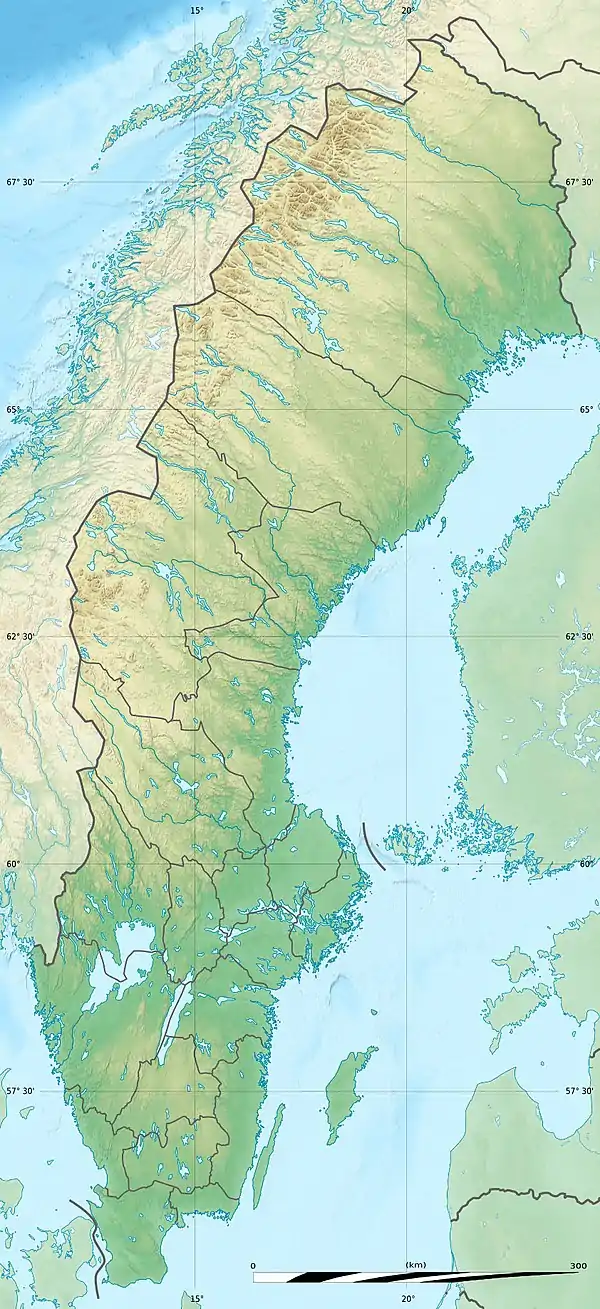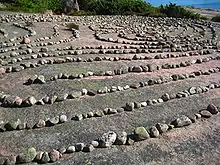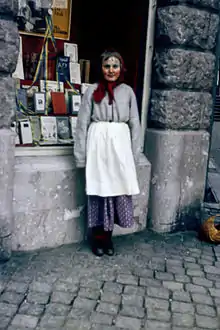Blå Jungfrun
Blå Jungfrun, also known as "Blåkulla", in English sometimes rendered literally as The Blue Maiden[2] is a Swedish island in the Baltic Sea. It is situated in the Kalmar Strait, between the mainland province of Småland and the island province of Öland. Administratively, the uninhabited island is part of the municipality of Oskarshamn and covers an area of approximately 0.7 km2 (0.27 sq mi) with a mean height above sea level of 86 m (282 ft). Home to black guillemots and a Swedish National Park since 1926, freedom to roam at Blå Jungfrun is limited with visitors prohibited from staying overnight on the island or making fires.
| Blå Jungfrun National Park | |
|---|---|
| Blå jungfruns nationalpark | |
IUCN category II (national park) | |
 | |
| Location | Kalmar County, Sweden |
| Nearest city | Oskarshamn |
| Coordinates | 57°15.1′N 16°47.6′E |
| Area | 1.98 km2 (0.76 sq mi)[1] |
| Established | 1926, extended 1988[1] |
| Visitors | 9,700 (in 1976) |
| Governing body | Naturvårdsverket |
| Website | Swedish Environmental Protection Agency |

The island consists partly of bare rock with the remainder covered in dense hardwood forest. There are several caves and an ancient stone labyrinth from which it is forbidden to remove stones.
Geologically the island is an ancient inselberg rising from the Sub-Cambrian peneplain. After its formation in the Precambrian, Blå Jungfrun was buried in sandstone, which protected it from any further erosion, until it was finally freed from its sandstone cover in geologically recent times.[3]
Legends

The island plays an important role in Swedish folklore, where it is viewed as an evil and magical place. The name Blå Jungfrun was originally used by sailors to avoid provoking the evil spirits who dwelt on the island. According to a widespread belief, related already by Olaus Magnus in 1555, witches meet there each Maundy Thursday. Carl Linnaeus, who visited the island in 1741, was sceptical:
Women and fairy-tales ... generally say that all witches will go here (truly a rather difficult journey) each Maundy Thursday; but those who have visited the place once are not likely to return, and should find out the reason for the fable: If any place in the world looks hideous, this is surely one of the most cruel.
The many water-polished stones on the beaches of Blå Jungfrun are illegal to remove from the island because of its national park status. And according to tradition, anyone who steals a stone from the island will suffer from bad luck until it is returned.[4] The town of Oskarshamn yearly receives stones from former Blå Jungfrun visitors, often with an accompanying letter describing misfortunes and disasters which happened to the letter writers after removing them. In May 2004, over 160 such stones were publicly brought back to the island on a ferry from Oskarshamn.[5]
Modern traditions

In Sweden and Swedish-speaking parts of Finland, to commemorate the travel of witches to sv:Blåkulla or according to some traditions Blå Jungfrun, children dress as witches, old women and old men on Easter and go door-to-door for treats similar to the trick-or-treating tradition of halloween. The children sometimes present hand-made cards and other greetings.[6]
Park establishment and tourism
Between 1904 and 1925 the red granite of Blå Jungfrun was extracted in three quarries on the south of the island. It was exported chiefly to Germany as decorative stone. The destruction led to efforts to protect the island. A donation from the Swedish entrepreneur Torsten Kreuger made it possible to acquire the island and stop the quarrying. The national park was established on February 5, 1926 by the Government of Sweden.[7]
In summer, the island can be visited by tour boats from Oskarshamn or from Byxelkrok.[8] Regular trips began in the 1950s. A park guide on Blå Jungfrun informs the visitors about the national park and its regulations. A visit to the island lasts for around 3,5 hours.
References
- "Blå Jungfrun National Park". Naturvårdsverket. Retrieved 2013-05-23.
- http://www.frommers.com/destinations/oland/side-trips
- Lidmar-Bergström, Karna. "Inselberg". Nationalencyklopedin (in Swedish). Cydonia Development. Retrieved June 22, 2015.
- ḎḤWTY. "Blå Jungfrun Island, Sweden: Where Witches Dwell and Labyrinths Confuse". Ancient Origins. Retrieved 21 March 2018.
- "Curse of the Stones", Fortean Times #219, February 2007, pp 44-48
- "Svenskspråkiga påskhäxor går ut på påskaftonen". Yle. March 13, 2010.
- Länsstyrelsen Kalmar - Blå Jungfrun. Archived February 7, 2014, at the Wayback Machine
- Solkustturer Boat to Blå Jungfrun
External links
| Wikimedia Commons has media related to Blå Jungfrun. |
- Sweden's National Parks: Blå Jungfrun National Park from the Swedish Environmental Protection Agency
- Blå Jungfrun (National Park) - Booking and timetable information for visiting Blå Jungfrun.